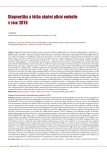The influence of some factors on presence of varices and variceal bleeding in liver cirrhosis patients
Authors:
L. Husová 1; P. Husa 2; P. Ovesná 3
Authors‘ workplace:
Interní gastroenterologická klinika Lékařské fakulty MU a FN Brno, pracoviště Bohunice, přednosta prof. MU Dr. Aleš Hep, CSc.
1; Klinika infekčních chorob Lékařské fakulty MU a FN Brno, pracoviště Bohunice, přednosta prof. MU Dr. Petr Husa, CSc.
2; Institut biostatistiky a analýz Lékařské a Přírodovědecké fakulty MU Brno, vedoucí doc. RNDr. Ladislav Dušek, Ph. D.
3
Published in:
Vnitř Lék 2011; 57(1): 61-71
Category:
Original Contributions
Overview
Study aim:
The aim of the study was to identify non‑invasive investigations that would provide a sufficiently reliable prediction of the presence of varices in patients with liver cirrhosis (LC) and identification of patients in a risk of variceal bleeding.
Patient sample and methodology:
As part of a prospective evaluation, 165 patients with alcoholic LC admitted to the Department of Internal Hepatology and Gastroenterology of the Medical School, Masaryk University in Brno between 2007 – 2009 were divided according to the presence of varices and variceal bleeding into three groups: I. patients with LC and varices with no variceal bleeding (N = 50), II. patients with LC with no varices and thus no variceal bleeding (N = 51), III. patients with LC and varices with confirmed variceal bleeding (N = 64). A statistical evaluation was performed of a range of haematological and biochemical parameters, spleen size and a thrombocyte, leucocyte and erythrocyte count to spleen size ratio.
Results:
Patients with varices (groups I and III) had, compared to patients with no varices (group II),a significantly larger spleen, lower thrombocyte count, lower plasma fibrinogen level, extended prothrombin time (higher INR), lower plasma GGT activity and lower erythrocyte, leucocyte and thrombocyte count to spleen size ratio. In the present cohort, statistically significant factors for the presence of variceal bleeding included lower erythrocyte count and lower level of haemoglobin, i.e. the expected effect of bleeding, lower fibrinogen serum levels, lower serum ALP activity, lower total serum protein and serum albumin, higher plasma levels of uric acid and lower leucocyte or erythrocyte count to spleen size ratio.
Conclusion:
Using common haematological and biochemical parameters together with spleen size enables, even without endoscopic examination, highly reliable prediction of the presence of varices and identification of patients in a high risk of variceal bleeding. When these non‑invasive methods are used, it is possible to eliminate the need for the invasive endoscopic examination that is frequently poorly tolerated by the patients and economically demanding.
Key words:
liver cirrhosis – variceal bleeding – predictive parameters
Sources
1. Fejfar T, Vaňásek T, Lata J. Krvácení při portální hypertenzi. In: Ehrmann J, Hůlek P et al. Hepatologie. Praha: Grada Publishing 2010, 171 – 186.
2. Vaňásek T. Endoskopické diagnostické a terapeutické metody. In: Ehrmann J, Hůlek P et al. Hepatologie. Praha: Grada Publishing 2010, 88 – 99.
3. Beppu K, Inokuchi K, Koyanagi N et al. Prediction of variceal hemorrhage by oesophageal endoscopy. Gastrointest Endosc 1981; 27 : 213 – 218.
4. Sarin SK, Lahoti D, Saxena SP et al. Prevalence, classification and natural history of gastric varices: a long‑term follow‑up study in 568 portal hypertension patients. Hepatology 1992; 16 : 1343 – 1349.
5. Giannini E, Botta F, Borro P et al. Platelet count/ spleen diameter ratio: proposal and validation of a non‑invasive parameters to predict the presence of oesophageal varices in patients with liver cirrhosis. Gut 2003; 52 : 1200 – 1209.
6. Giannini EG, Zaman A, Kreil A et al. Platelet count/ spleen diameter ratio for the noninvasive diagnosis of oesophageal varices: result of a multicenter, prospective, validation study. Am J Gastroenterol 2006; 101 : 2511 – 2519.
7. Alempijevic T, Bulat V, Djuranovic S et al. Right liver lobe/ albumin ratio: contributio to non‑invasive assessment of portal hypertension. World J Gastroentero 2007; 13 : 5331 – 5335.
8. Baig WW, Nagaraja MV, Varma M et al. Platelet count to spleen diameter ratio for the diagnosis of oesophageal varices: is it feasible? Can J Gastroenterol 2008; 22 : 825 – 828.
9. Bitetto D, De Bernardi ‑ Venon W, Fabris C et al. Platelet count/ spleen diameter ratio compared to HVPG and transient elastography to predict severe portal hypertension in patients with liver cirrhosis. J Hepatol 2010; 52 (Suppl 1): S159.
10. Barrera F, Riquelme A, Doza A et al. Platelet count/ spleen diameter ratio for non‑invasive prediction of high risk esophageal varices in cirrhotic patients. Ann Hepatol 2009; 8 : 325 – 330.
Labels
Diabetology Endocrinology Internal medicineArticle was published in
Internal Medicine

2011 Issue 1
Most read in this issue
- A delay in the HELLP syndrome diagnosis
- Diagnosis and treatment of acute pulmonary embolism in 2010
- Obesity, body mass index, waist circumference and mortality
- A case of a flapping infected thrombus in the internal jugular vein, septic pneumonias and heparin‑induced thrombocytopaenia
